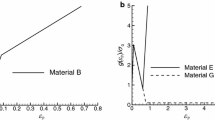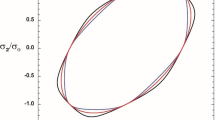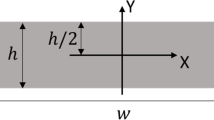Abstract
To explore constraint effects on fully plastic crakc-tip fields, analytical solutions are examined for mode-I, II and III loading in non-hardening materials under plane strain conditions. The results reveal that under mode-II and III loading the crack-tip stress fields are unique, and thus can be characterized by a `single parameter'. Under mode-I loading, however, the crack-tip stress field is non-unique but can be characterized by two sets of solutions or `two parameters'. One set of the solutions is the well-known Prandtl field and the other is a plastic T-stress field. This conclusion corroborates the observation of McClintock (1971) that the slip-line field is non-unique for plane strain tensile cracks. A two-term plastic solution which combines the Prandtl field and the plastic T-stress field with two parameters B 1 and B 2 can then characterize the crack-tip stress field of plane strain mode-I crack over the plastic region and quantify the magnitude of crack-tip constraints. These characters are similar to those for hardening materials. Analyses and examples show that the two-term plastic solution can match well with the slip-line field or finite element results over plastic region. Thus the parameters B 1 and B 2 can be used to characterize the constraint level for mode-I finite-sized crack specimens in non-hardening materials under plane strain conditions.
Similar content being viewed by others
References
Betegon, C. and Hancock, J.W. (1991). Two-parameter characterization of elastic-plastic crack-tip fields. Journal of Applied Mechanics 58, 104–110.
Chao, Y.J. and Yang, S. (1996). Higher order crack tip fields and its implication for fracture of solids under mode II conditions. Engineering Fracture Mechanics 55, 777–794.
Chao, Y.J., Yang, S. and Sutton, M.A. (1994). On the fracture of solids characterized by one or two parameters: theory and practice. Journal of the Mechanics of Physics and Solids 42, 629–647.
Chao, Y.J. and Zhu, X.K. (1998). J - A 2 Characterization of crack-tip fields: extent of J - A 2 dominance and size requirements. International Journal of Fracture 89, 285–307.
Ewing, D.J.F. and Hill, R. (1967). The plastic constraint of V-notched tension bars. Journal of the Mechanics and Physics of Solids 15, 115–121.
Ewing, D.J.F. (1968). Calculations on the bending of rigid/plastic notched bars. Journal of the Mechanics and Physics of Solids 16, 205–213.
Green, A.P. (1956). The plastic yielding of shallow notched bars due to bending. Journal of the Mechanics and Physics of Solids 4, 259–268.
Green, A.P. and Hundy, B.B. (1956). Initial plastic yielding in notch bending tests. Journal of the Mechanics and Physics of Solids 4, 128–144.
Hutchinson, J.W. (1968a). Plastic stress and strain fields at a crack tip. Journal of the Mechanics and Physics of Solids 16, 337–347.
Hutchinson, J.W. (1968b). Singular behavior at the end of a tensile crack in a hardening material. Journal of the Mechanics and Physics of Solids 16, 13–31.
Ibragimov, V.A. and Tarasyuk, N.E. (1976). Asymptotic behavior of stress state near crack tip in elastic-ideally plastic medium. Izv. AN SSSR. Mekhanika Tverdogo Tela 11, 184–185.
Kim, Y.-J., Lin, G., Cornec, A. and Schwalbe K.-H. (1996). Fully plastic crack-tip fields for plane strain shallowcracked specimens under pure bending. International Journal of Fracture 78, 21–34.
Larsson, S.G. and Carlsson, A.J. (1973). Influence of non-singular stress terms and specimen geometry on smallscale yielding at crack tips in elastic-plastic material. Journal of the Mechanics and Physics of Solids 21, 263–278.
Lee, H. and Parks, D.M. (1993). Fully plastic analyses of plane strain single-edge-cracked specimens subject to combined tension and bending. International Journal of Fracture 63, 329–349.
Li, J. and Hancock, J.W. (1999). Mode I and mixed mode fields with incomplete crack tip plasticity. International Journal of Solids and Structures 36, 711–725.
McClintock, F.A. (1971). Plasticity aspects of fracture. Fracture: An Advanced Treatise (Edited by H. Liebowitz) Vol. 3, Academic Press, New York, 47–225.
Nemat-Nasser, S. and Obata, M. (1991). On stress field near a stationary crack tip. Mechanics of Materials 3, 235–243.
O'Dowd, N.P. and Shih, C.F. (1991). Family of crack-tip fields characterized by a triaxiality parameter-I. Structure of fields. Journal of the Mechanics and Physics of Solids 39, 989–1015.
Prandtl, L. (1920). Ueber die Haerte plastischer Koerper. Goettinger Nachr., math.-phys. Kl., 74–85.
Rice, J.R. (1968a). Mathematical analysis in the mechanics of fracture. Fracture II (Edited by H. Liebowitz), 191–311.
Rice, J.R. (1968b). A path independent integral and the approximate analysis of strain concentration by notches and cracks. Journal of Applied Mechanics 35, 379–386.
Rice, J.R. and Rosengren, G.F. (1968). Plane strain deformation near a crack tip in a power-law hardening material. Journal of the Mechanics and Physics of Solids 16, 1–12.
Shih, C.F. and German, M.D. (1981). Requirements for a one parameter characterization of crack tip fields by the HRR singularity. International Journal of Fracture 17, 27–43.
Wu, S.-X., Mai, Y.-W. and Cotterell, B. (1990). Plastic η-factor (ηp) of fracture specimens with deep and shallow cracks. International Journal of Fracture 45, 1–18.
Yang, S., Chao, Y.J. and Sutton, M.A. (1993). Higher order asymptotic crack tip fields in a power-law hardening material. Engineering Fracture Mechanics 45, 1–20.
Yang, S., Yuan, F.G. and Cai, X. (1996). Higher order asymptotic elastic-plastic crack-tip fields under anti-plane shear. Engineering Fracture Mechanics 54, 405–422.
Zhu, X.K. and Chao, Y.J. (1999). Characterization of constraint of fully plastic crack-tip fields in non-hardening materials by the three-term solution. International Journal of Solids and Structures 36, 4497–4517.
Zhu, X.K. and Chao, Y.J. (2000). Fully plastic crack-tip fields for CCP and DECP specimens under tension in non-hardening materials. International Journal of Fracture 37, 577–598.
Zhu, X.K., Hwang, K.C. and Liu, G.T. (1997). Continuous near-tip fields for a dynamic crack propagating in a power-law elastic-plastic material. International Journal of Fracture 85, 201–209.
Author information
Authors and Affiliations
Rights and permissions
About this article
Cite this article
Chao, Y., Zhu, X. Constraint effects on plastic crack-tip fields for plane strain mode-I, II and III cracks in non-hardening materials. International Journal of Fracture 105, 187–207 (2000). https://doi.org/10.1023/A:1007643127900
Issue Date:
DOI: https://doi.org/10.1023/A:1007643127900




